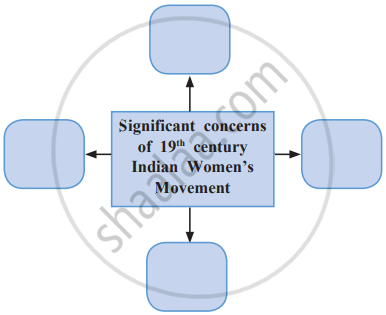Advertisements
Advertisements
प्रश्न
Write differences.
Pre-Independence and Post-Independence periods of the Women’s Movement in India.
Write differences:
Pre-Independence women's movement and Post-Independence women's movement.
Women's movement during Pre-Independence period and Women's movement during Post-Independence period.
उत्तर
| No. | Pre-Independence period of the Women’s Movement | Post-Independence period of the Women’s Movement |
| i. | Its roots can roughly be traced to the beginning of the 19th century. | It refers to the Women’s Movement that took place after 15th August 1947. |
| ii. | Women became more aware of their status and position. Liberalism in thought and approach encouraged women to educate themselves. | The period witnessed a slowing down of the Women’s Movement. Several issues led to the collective struggles and took away the singular focus of the Women’s Movement. |
| iii. | Social reformers challenged customary practices that were discriminatory. Also, conscious efforts were made to educate women. | This phase focused on sex stereotyping, violence against women, and legislative demands for the equality of women. |
| iv. |
Important points:
|
Important points:
|
| v. | The British government passed legislation such as the Sati Prohibition Act (1829), the Widow Remarriage Act (1856), and others. | Three important points are covered as a result of post-independence movements: the struggle for equal rights, the elimination of discriminatory practices, and the realisation and actualisation of women's potential to empower themselves. |
APPEARS IN
संबंधित प्रश्न
Write a short note on Women’s Movement.
Would you consider the anti-arrack movement as a women’s movement? Why?
Correct the underlined words and complete the statement.
The Theosophical Society was the initiative of Mahatma Gandhi.
Correct the incorrect pair and rewrite it.
Correct the underlined words and complete the statement.
The Women’s Indian Association was formed in Bombay.
Complete the concept map.

The years 1975-1985 was announced as the international decade for ______.
The All India Women’s Conference was established in the year ______.
State whether the following statement are true or false with reason.
Education has no effect on women’s empowerment.
Give your personal response.
Discuss the need for women’s education.
Match the following:
| Column 'A' | Column 'B' |
| (i) International Women's Year | (a) 2012 |
| (ii) Mathura Rape Case | (b) 1975 |
| (iii) Roop Kawar Sati case | (c) 1972 |
| (iv) Nirbhaya rape case | (d) 1987 |
In the mid–1970s, there was a renewal of the women’s movement in India which was called the second phase of the Indian women’s movement. There was the growth of what is termed as the autonomous women’s movements.
How can these movements be called autonomous?
In the mid–1970s, there was a renewal of the women’s movement in India which was called the second phase of the Indian women’s movement. There was the growth of what is termed as the autonomous women’s movements.
Write about any one ideological change that was noticed in the autonomous women’s movement.
In which period there was growth of anthonomus women's movements?
Complete the concept map:

Correct the incorrect pair and rewrite it:
Identify the appropriate term from the given options and rewrite it against the given statement:
The title is used for female freedom fighters in India.
Correct the underlined word, and complete and rewrite the statement:
Nirbhaya Rape Case occurred in the year 2002.
State any two programmes launched by the NDA government after 2014 for women’s help and progress.
Identify the appropriate term from the given options and rewrite it against the given statement:
Worked for prohibition of child marriage.
